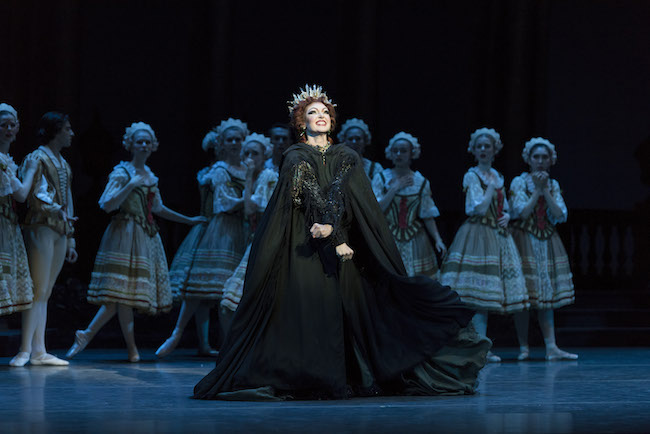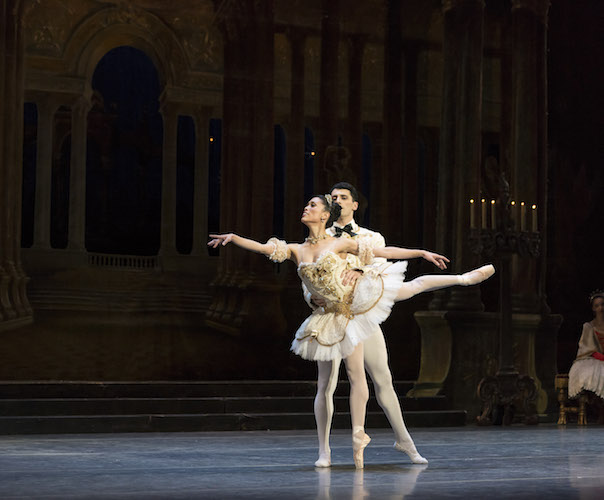Dance Review: Boston Ballet — The Whole Enchilada
Sleeping Beauty needs not only to thrill us but to carry us somewhere back into its own history.
The Sleeping Beauty, Boston Ballet. Opera House, Boston, MA, through May 19.

Kathleen Breens Combes and Boston Ballet in Marius Petipa’s “The Sleeping Beauty.” Photo: Liza Voll Photography.
By Marcia B. Siegel
Among classical ballets, The Sleeping Beauty is the whole enchilada. In three acts and a prologue, Beauty, first produced in 1890, displays a ballet company’s full resources, its ability to spark the theatrical imagination. The whole ballet is full of pageantry and processions. The stars, Princess Aurora and Prince Desire, don’t appear until after the Prologue, when gifts in the form of blessings are presented to the baby princess by the fairies. Each fairy has a solo variation in which she confers her gift. Addie Tapp, the Lilac Fairy, is the benevolent spirit of the proceedings, rescuing the princess from the curse of the bad fairy, Carabosse (Kathleen Breen Combes).
Breen Combes doesn’t have much dancing to do, but she projects a forceful idea about the character. Carabosse is quite glamorous, and vain enough to invoke dire consequences because she hasn’t been invited to the christening. She hurls big, end-stopped gestures like weapons in all directions and finally invokes her revengeful gift. Aurora will prick her finger and die. The Lilac Fairy intervenes with her gift: the princess will be saved with a 100-year sleep instead of death.
Tapp presides over the other fairies with gracious gestures and a gentle smile. Her Lilac Fairy is a powerful but sympathetic presence. After foiling Carabosse at the christening, she appears years later, carrying out her promise to save Aurora from the fatal spindle-prick. A century later, she leads the Prince through a dense forest to the enchanted Aurora. At the gates of the spellbound castle, she dispatches Carabosse again. Inside the palace she shows Desire what to do with the beautiful vision he discovers lying on the bed, by lightly touching her hand to her temple. One tender kiss and Aurora wakes up, and they immediately fall in love. Their marriage will safeguard the monarchy.
The Aurora and Desire in the opening night cast were Lia Cirio and Lasha Khozashvili, both fine classical dancers. They can be a bit bland expressively, but they dance the grand steps grandly. In the Act 3 Wedding scene we get to see ballet’s spectacular leaps and small batterie, we savor the long balances and changing, elegant positions as they show off for each other.
Much earlier, at her birthday party, Cirio has demonstrated demanding balances on pointe in the Rose Adagio, acknowledging the four foreign suitors who offer to support her one after the other. Without coming off pointe, she leans on each man in turn, in a series of daring feats. With one leg standing and the other lifted back in attitude, she raises her arms from the suitor’s support, to balance alone as the next man walks up to steady her. She pirouettes into each partner’s arms, adding one more turn for each partner. In the last set, she accepts a rose from each man while turning.
The Sleeping Beauty is more than stellar dancers and their exploits. Between the story scenes and the virtuosity there’s a lot of ensemble dancing. The ensemble is featured in different guises: the five junior fairies in formal lines with their escorts and attendants; the Lilac Fairy’s nymphs who circle around the Prince’s first vision of Aurora; the villagers with flower-twined hoops who celebrate Aurora’s birthday in the Garland Dance. My favorite in any production is the courtly dance in the Act 2 hunting scene, beginning with the countesses and gentlemen. The peasants stand on the sidelines and gradually infiltrate the formal dance. Eventually peasants and nobles join in a lively farandole.
Then there are the small character and comedy bits. After the spindle curse, all pointy things are forbidden in the kingdom. Three women are caught knitting and are chastised, then pardoned at the behest of the Queen, Aurora’s mother. In the Act 2 picnic, the guests amuse themselves by teasing the prince’s tutor with a game of blind man’s buff.

Lia Cirio and Lasha Khozashvili in Boston Ballet’s production of Marius Petipa’s “The Sleeping Beauty.” Photo: Liza Voll Photography.
In the last act, Petipa made dancing and comedy vignettes based on well-known fairy tale characters. The cats, Puss in Boots and the White Cat (Lawrence Rines and Haley Schwan), push me past my tolerance for cuteness as they act out Tchaikovsky’s scratches and meows. But the Bluebirds (Misa Kuranaga and Junxiong Zhao) don’t beg for laughs. Their pas de deux is spectacular but much less noble and sedate than that of the wedding couple. Both are small dancers with beautiful carriage and clean lines. Kuranaga’s quick, precise footwork and Zhao’s effortless jumps alternate with and are sometimes accompanied by finger and foot fluttering that illustrates the chirpy music.
Though the old fairy tale has been rechoreographed many times (besides Disney and innumerable reconceived stage productions, there’s an ice-dancing version), something close to Marius Petipa’s original can endure, thanks to diligent curatorship and the wonderful score by Tchaikovsky. The current series of performances is being guest-conducted by Ming Luke, who’s based in the San Francisco Bay Area and frequently leads the SF Ballet orchestra. Ming lifted the Boston orchestra to a lively pace, with some very apt changes of speed and intensity that invoked a collective response in the corps de ballet.
Boston’s Beauty has been handed down in the version done by Britain’s Royal Ballet under Ninette de Valois, with additional choreography by Frederick Ashton. This version established the Royal Ballet’s national importance after World War II, and symbolized the restoration of civilized society. Boston’s handsome production, designed by David Walker with lighting design by John Cuff, is sumptuous in period detail with its four different settings and lavish costumes. It entered Boston Ballet’s repertory in 2005 and was last seen here in 2017.
It seems that retired principal dancer Larissa Ponomarenko, now a balletmaster, coached some of the dancers, and she may have supervised the whole production that returned to the repertory last week. But why was no one credited for this? Unlike recorded music, ballets don’t live without being nurtured. It’s impossible to trace exactly what occurred and who was responsible over this ballet’s 110-year evolution. What matters in any revival is how it speaks to the audience. Sleeping Beauty needs not only to thrill us but to carry us somewhere back into its own history. Too bad only two more performances will be done this season.
Internationally known writer, lecturer, and teacher Marcia B. Siegel covered dance for 16 years at The Boston Phoenix. She is a contributing editor for The Hudson Review. The fourth collection of Siegel’s reviews and essays, Mirrors and Scrims—The Life and Afterlife of Ballet, won the 2010 Selma Jeanne Cohen prize from the American Society for Aesthetics. Her other books include studies of Twyla Tharp, Doris Humphrey, and American choreography. From 1983 to 1996, Siegel was a member of the resident faculty of the Department of Performance Studies, Tisch School of the Arts, New York University.

